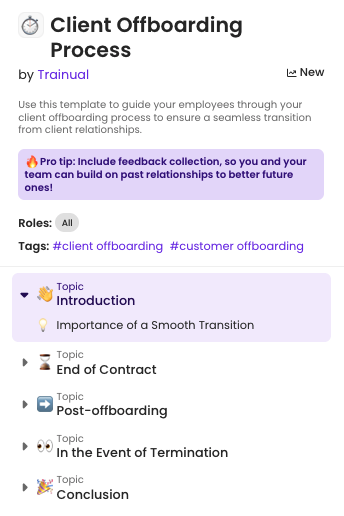Your customers are leaving. Are you guilty of one of these reasons?
February 28, 2024

Hot off the SMB press this week:
- A template to share your process for offboarding clients.
- The reasons why your customers are leaving — and how to change that.
- How one Trainual customer uses the platform to set their employees up for success.
- And why self-care really is the key to caring for your business.
STARTER PACK
Template of the week: Client Offboarding Process

What would you say if we told you that the offboarding process should be treated with the same care as onboarding?
a. We do exactly that!
b. Ain’t nobody got time for that.
If your answer is b, you’re overlooking a crucial phase of the customer journey. A thoughtfully created offboarding process reflects your company’s commitment to excellence across all client interactions.
Not only can a good client offboarding process ensure a smooth transition for the client, but it can help you gather valuable feedback, handle data securely, and foster lasting client relationships (which can lead to referrals, networking opportunities, and re-engagement in the future).
👉 And you know we got you with our Client Offboarding Process template. It covers everything from the importance of a smooth transition, to what to do for a contract conclusion, to maintaining relationships post-offboarding. Plus, it even goes over what to do about a premature contract termination. Make edits as necessary and it’s ready to share with your customer service team.
Want more templates to help you build your business playbook? Check out our entire template archive of free, multimedia-enhanced, and customizable policy, process, and role starters. New to Trainual? Get a demo.
WON’T YOU STAY WITH ME?
9 preventable reasons customers leave your business
Can you handle the truth?
Customers are going to leave your business. Sometimes, their needs change and they head off to find a new solution — and that’s okay! Other times, it was you, not them, and their leaving could have been prevented. And no, the sad eyes can’t make them stay.
.gif)
What can keep the rest of them around is paying attention to the reasons people leave — and making adjustments so you don’t lose anyone else. Here are nine hidden reasons your customers may be leaving you:
- Poor product or service quality. Surveys and feedback are your friends. You always want to improve your offerings — otherwise, you’ll be hearing sayonara from more and more customers.
- Weak onboarding. Do you provide all the resources to help your new customers get up and running fast? Not quite? Then what are you waiting for? (What may help: this new customer onboarding process template!)
- No value realization. Bells and whistles are fun, but if your products and services don’t actually address what your customer needs, they’ll walk away — no matter how shiny and fun your business is. Establish check-ins to help your customers get the most out of your offerings.
- Poor communication. “Out of sight, out of mind” — so, if you’re not communicating with your customers, chances are they’ll forget all about you. But you also don’t want to bombard them with constant emails or social posts. Find a balance that keeps you visible without annoying customers into unsubscribing.
TRAINUAL TIPS & TRICKS
How Keene Perspectives uses Trainual to set employee expectations
Who else loved getting a gold star on their report card in elementary school? It’s too bad that nowadays, earning that praise isn’t as simple as getting good grades or being a nice friend to your classmates (starting a petition to get “Good job!” stickers on the job ASAP).
Expectations for performance management are going to differ from business to business — and your new employees won’t have a clue as to how they’re being evaluated unless you share that with them.
Which is why healthcare provider Keene Perspectives sets their team up for success early with their “Total Performance System (TPS)” training subject. It outlines exactly what employees should expect for performance evaluations — from expectations and competencies to their review scoring system and evaluation categories.

That way, not only is there consistency and transparency in their employee evaluations, the training sets employee expectations right from the start.
Want to set up your own performance management training in Trainual? Get a demo.
REAL TALK
How taking care of yourself helps you take care of your business

You’ve heard it before: You need to take care of yourself before you can take care of your business. But is this golden nugget of wisdom getting talked about enough? Our two cents: If it’s really true that you are your own bottleneck to business success (and it is), then it's time we shine a big, glittering spotlight on the art of self-care.
Repeat after us: Self-care is not self-indulgence.
Perhaps you’ve recently embarked on a culinary adventure where you single-handedly defeated an entire cake, bite by bite. While we don’t judge (#TreatYoself), this kind of self-indulgence it’s just not the same as self-care.
Self-care is about making choices that enhance your well-being and quality of life. Think of it this way: By taking care of yourself you’re making a strategic investment in your success — both personally and professionally.
Here’s how to take control of your self-care:
Start with the classic forms of self-care — returning to a forgotten hobby, scheduling time away from technology, learning something new, or practicing random acts of kindness — and figure out what works for you. Then, be sure to revisit your stressors:
- Do you feel like there’s not enough time in the day? (Hah, that’s a good one. That is rich.) But on a real note — delegation is the solution to all your woes. When you delegate those pesky tasks you just don’t have time for (and realistically shouldn’t be doing) it’ll free up your time for other things. (Psst… Trainual can help with that, wink.)




